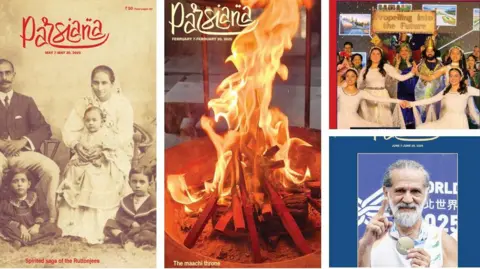When Anuparna Roy accepted the Orizzonti Award for her debut film Songs of Forgotten Trees in Venice earlier this month, she'd forged a victory that's rare for most women of her background. Trembling with joy and unable to hold back tears, Roy's visceral display of emotion on stage demonstrated how big the moment was - scripting history as the first Indian director to win in a category specially devoted to new voices in independent world cinema.
That itself is a towering achievement, but Roy's grassroots origins in a nondescript tribal village in West Bengal state's Purulia district - thousands of miles from Venice's glamorous palazzos - makes her triumph even more meaningful. From Ritwik Ghatak to Satyajit Ray to Mrinal Sen, Bengal has produced many globally celebrated auteurs. But unlike them, Roy, 31, grew up far away from the elite cultural influences of Kolkata, and took a path more well-worn by small-town Indians - a college degree followed by a call-centre job.
It was an escape route from the pressures of marrying and a means to economic stability, Roy told me over a Zoom chat. But it ended up becoming much more. While peddling IT software in Delhi, a chance meeting with film students triggered a love affair with cinema and Roy saved every penny earned over the next six years to self-fund her debut short Run to the River.
After moving to Mumbai a few years later, she tracked down Ranjan Singh, the lead producer of Songs of Forgotten Trees, at a party and asked him bluntly: Sir, would you like to produce a third-world film? Taken aback by her boldness, Singh asked Roy to meet him the following day and narrate the idea in less than 10 minutes. The meeting lasted well over a few hours, and within days he had agreed to fund the project.
A hardcore fan of director Anurag Kashyap's operatic crime-drama Gangs of Wasseypur, Roy persuaded Singh to show the film to Kashyap, who ended up backing it. Set in the pulsating heart of Mumbai, Songs of Forgotten Trees tells the story of two women from entirely different worlds - Thooya, an aspiring actress who moonlights as an escort, and Swetha, a fellow migrant with a call centre job. They live together in the upscale apartment of Thooya's sugar daddy.
What begins as a living arrangement quickly transforms into an intimate relationship between the two women as they navigate same-sex desire and shared experiences of marginality and survival in an urban sprawl. The Hollywood Reporter called the film 'an anguished portrait of what it takes for women to survive', and a 'clear-eyed, restrained, moving story' of two young women finding solace in each other.
Another review praised Roy's exploration of urban alienation with 'remarkable subtlety', highlighting her deliberately slow, observational style of filming which allows the 'emotional terrain' of the characters to emerge with clarity. Formally untrained in the craft, Roy said it was a conscious decision to not follow the traditional rules of filmmaking with 'long, mid and close shots' and instead capture the rhythms of her characters' daily routine more authentically with continuous takes.
Songs of Forgotten Trees is deeply personal for Roy. It was initially intended as a documentary - the central characters are inspired by the lives of Roy's grandmother and her stepdaughter, who shared a platonic but quietly intimate relationship. Another character, Jhumpa, who is Thooya's friend, is based on Roy's own childhood friend from the Dalit community who was married off at the age of 12. The film has sparked discussions on social media, especially regarding Roy's choice to wear a saree representing both her heritage and political stance during her acceptance speech at Venice.
As she looks forward to future projects, including sequels to her debut film, Roy states firmly she won't conform to commercial cinema's expectations. I can't make sugar-coated cinema. I have to make films that represent the world we live in, even if they upset people.\
That itself is a towering achievement, but Roy's grassroots origins in a nondescript tribal village in West Bengal state's Purulia district - thousands of miles from Venice's glamorous palazzos - makes her triumph even more meaningful. From Ritwik Ghatak to Satyajit Ray to Mrinal Sen, Bengal has produced many globally celebrated auteurs. But unlike them, Roy, 31, grew up far away from the elite cultural influences of Kolkata, and took a path more well-worn by small-town Indians - a college degree followed by a call-centre job.
It was an escape route from the pressures of marrying and a means to economic stability, Roy told me over a Zoom chat. But it ended up becoming much more. While peddling IT software in Delhi, a chance meeting with film students triggered a love affair with cinema and Roy saved every penny earned over the next six years to self-fund her debut short Run to the River.
After moving to Mumbai a few years later, she tracked down Ranjan Singh, the lead producer of Songs of Forgotten Trees, at a party and asked him bluntly: Sir, would you like to produce a third-world film? Taken aback by her boldness, Singh asked Roy to meet him the following day and narrate the idea in less than 10 minutes. The meeting lasted well over a few hours, and within days he had agreed to fund the project.
A hardcore fan of director Anurag Kashyap's operatic crime-drama Gangs of Wasseypur, Roy persuaded Singh to show the film to Kashyap, who ended up backing it. Set in the pulsating heart of Mumbai, Songs of Forgotten Trees tells the story of two women from entirely different worlds - Thooya, an aspiring actress who moonlights as an escort, and Swetha, a fellow migrant with a call centre job. They live together in the upscale apartment of Thooya's sugar daddy.
What begins as a living arrangement quickly transforms into an intimate relationship between the two women as they navigate same-sex desire and shared experiences of marginality and survival in an urban sprawl. The Hollywood Reporter called the film 'an anguished portrait of what it takes for women to survive', and a 'clear-eyed, restrained, moving story' of two young women finding solace in each other.
Another review praised Roy's exploration of urban alienation with 'remarkable subtlety', highlighting her deliberately slow, observational style of filming which allows the 'emotional terrain' of the characters to emerge with clarity. Formally untrained in the craft, Roy said it was a conscious decision to not follow the traditional rules of filmmaking with 'long, mid and close shots' and instead capture the rhythms of her characters' daily routine more authentically with continuous takes.
Songs of Forgotten Trees is deeply personal for Roy. It was initially intended as a documentary - the central characters are inspired by the lives of Roy's grandmother and her stepdaughter, who shared a platonic but quietly intimate relationship. Another character, Jhumpa, who is Thooya's friend, is based on Roy's own childhood friend from the Dalit community who was married off at the age of 12. The film has sparked discussions on social media, especially regarding Roy's choice to wear a saree representing both her heritage and political stance during her acceptance speech at Venice.
As she looks forward to future projects, including sequels to her debut film, Roy states firmly she won't conform to commercial cinema's expectations. I can't make sugar-coated cinema. I have to make films that represent the world we live in, even if they upset people.\


















